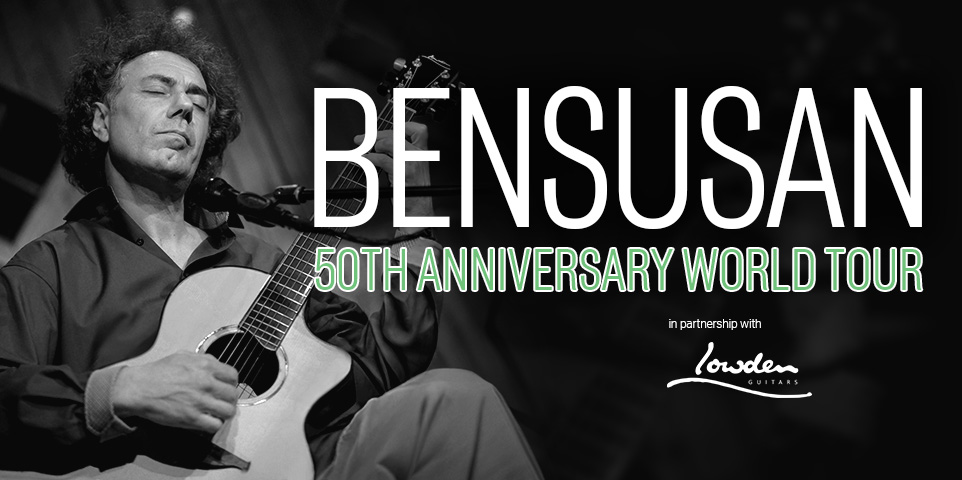Press Release
INTERVIEW BY BRIAN GORE (USA)
For a book published by Mel Bay
Brian Gore:
1. Describe the considerations leading you to specialize in the DADGAD tuning.
Pierre Bensusan:
Being self taught on the guitar, I went away from the academic approach and have played several alternative tunings, which you can hear on my first 2 albums Pres de Paris and 2. However, in 1978, I decided to stick with only one tuning in order to learn the fundamentals on the guitar, and chose Dadgad. The album Musiques recorded in 1979 is my first recording using Dadgad throughout the album.
2. What are the advantages of your tuning?
PB: I view Dadgad in the way most guitar players view standard tuning. I take as much advantage of its natural sounding qualities, and yet can go away from it and play in any key, with no open string. The tuning is not the most crucial element, the inspiration, the ideas and their translation into a guitaristic musical form, the organization and architecture of the music, the feel, the groove, the music itself... are the keys. This tuning has certainly helped me to sound differently from any other guitarist and articulate and phrase differently, have maybe more fun and understand what I had inside that wanted to come out; but sincerely, as much as Dadgad is now a natural extension of myself, I could have very well achieved the same or different results in standard tuning and have as much pleasure in the process. At the end of the day, the music is the guide, not the tuning. If you let the tuning control you, you will end up sounding like nothing.
3. How have you addressed limitations in your tuning, if they exist at all?
PB: By deepening my approach of it, going away from the obvious fingerings and reflexes, following the music and not systematically what my fingers liked to play. I have also worked on the agility of my left hand so that I could gradually address the stretching issues, more pronounced here because of these 3 strings tuned down one step, and so a bit more sensitive to deal with here than in the standard tuning context. All the chords, scales, modes and all the rest of it, are there in an agreeable and playable form, which makes a good ergonomic and sonic sense.
4. What strategies would you recommend to someone to acquire your level of fret board knowledge in an open tuning they adopt?
PB: I don't believe fretboard knowledge has anything to do with the tuning. Whatever the tuning you chose to play, ideally, you should know your way around as much as possible. It all has to do with the time you spend, the fun you have studying the fretboard and the level of musicality that is inherent of each of us. As much as I relie on the fretboard and coincidences encountered when playing randomly my guitar, I relie even more strongly on my imagination and inner music to tell me what are the next notes I should play.
5. What fingering techniques do you use for solo lines? When generally do you use each combination of fingerings (PI vs IM, and also combinations of IMA) to execute your solo passages. When do you use a thumbpick?
PB: I started by always using a thumbpick and played the solo lines using the Luth Technique: p,i - p,m, p,i - p,m, etc. Several years ago, I have gradually changed my right hand technique and hardly use a thumpick today. I play solo lines with picking or rest stroke techniques using i,m,a (ring finger) with my thumb often resting on one bass, as in Flamenco. At times I would go back to lute technique as well, and use a combination of everything. I also use my little finger for chords which contain more than 4 voices, or roll my thumb on several bass strings.
6. Describe the importance of singing in developing and performing your music.
PB: The voice is our first instrument; we always have it handy and it could naturally be used to give a sound to and melodic, harmony, bass line idea, etc. Any voicing can be met and identified with the voice. It helps to bring the music inside.
7. What essential characteristics must a song have, in your opinion, for it to be great?
PB: I am not sure I can describe in words what a song or music should have to be great. We see that, thank God, there is no recipe. But space, chant, movement, grace, dynamics, tempo, contrasts, unpredictability and yet comfort, etc. are essential qualities for the music to exist and find its bed. It should be done in a sincere way and one should not be preoccupied by any issue, result or projection in the future, other than the artistry and the music itself, whatever time it takes to produce it. As much as I have a hard time describing what the elements which put together a success are, I, like a lot of people who are not necessarily adept at an instrument, know right away when it's not working.
8. What creative techniques do you use to identify and develop your ideas?
PB: I stay with my ideas a long time in an inner circle and feed them constantly. I also sing and accompany myself on the guitar, then I start to bring the elements on the guitar and decide then if the voice is still necessary or if the guitar can stand by itself.
9. How do you become unstuck?
PB: By not thinking that I am stuck.









